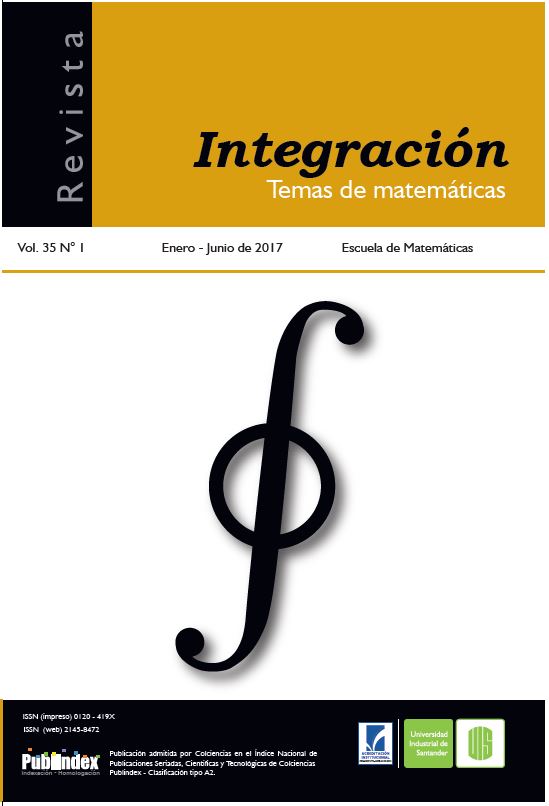Research and Innovation Articles
Geostatistics applied to autorregresive time series: A simulation study
Published 2017-08-09
Keywords
- Autocorrelation,
- Kriging,
- Prediction,
- Missing values,
- Semivariogram
- Time series,
- Variogram ...More
How to Cite
Giraldo, R., Pacheco, Óscar, & Orozco, A. (2017). Geostatistics applied to autorregresive time series: A simulation study. Revista Integración, Temas De matemáticas, 35(1), 83–102. https://doi.org/10.18273/revint.v35n1-2017006
Abstract
Geostatistics can be used as a method for predicting missing data in time series. The procedure is based on estimating the temporal autocorrelation structure by means of the semivariance function, by least squares (classical geostatistics) or maximum likelihood (model-based geostatistics), and posteriorly using Kriging for doing prediction of missing data in the time series. In this work we compare classical and model-based geoestatistics in the context of time series using simulated autorregresive time series.
Downloads
Download data is not yet available.
References
[1] Box G., Jenkins G. and Reinsel G., Time Series Analysis: Forecasting and Control, John Wiley & Sons, New York, 2008.
[2] Cressie N., Statistical for Spatial Data, John Wiley & Sons, New York, 1993.
[3] De Iaco S., Palma M. and Posa D., “Geostatistics and the Role of Variogram in Time Series Analysis: A Critical Review”, en Statistical Methods for Spatial Planning and Monitoring ( ed. Montrone S. and Perchinunno P.), Springer-Verlag, Milan, 2013.
[4] Diggle P. and Ribeiro P., Model-based Geostatistics, Springer-Verlag, New York, 2007.
[5] Dowdall M., Bjorn L., Gerland S. and Rudjord A., “Geostatistical analysis as applied to two environmental radiometric time series”, Environmental Monitoring and Assessment 83 (2003), No. 1, 1–16.
[6] Ghahraman B. and Ahmadi F., “Application of geostatistics in time series: Mashhad annual rainfall”, Iran Watershed Management Science and Engineering 1 (2007), No. 1, 7–15.
[7] Haslett J., “On the sample variogram and sample autocovariance for non-stationary time series”, Journal Royal Statistical Society Series D 46 (1997), No. 4, 475–484.
[8] Hollander T. and Wolfe D., Nonparametric Statistical Methods, John Wiley & Sons, New York, 1999.
[9] Ljung G., “A note on the estimation of missing values in time series”, Comm. Statist. Simulation Comput. 18 (1989), No. 2, 459–465.
[10] Ma Ch., “The use of the variogram in construction of stationary time series models”, J. Appl. Probab. 41 (2004), No. 4, 1093–1103.
[11] Margalef R., Limnología, Ediciones Omega, Barcelona, 1983.
[12] Peña D. and Tiao G., “A note on likelihood estimation of missing values in time series”, Amer. Statist. 45 (1991), No. 3, 212–213.
[13] R Core Team, R: A Language and Environment for Statistical Computing, R Foundation for Statistical Computing, Vienna, 2013.
[14] Ribeiro P. and Diggle P., “geoR: a package for geostatistical analysis”, R-NEWS 1 (2001), No. 2, 15–18.
[15] Rouhani S. and Myers D., “Problems in space time Kriging of geohidrological data”, Mathematical Geology 5 (1990), No. 22, 611–623.
[16] Schabenberger O. and Gotway C., Statistical Methods for Spatial Data Analysis, Chapman & Hall, Boca Ratón, 2005.
[2] Cressie N., Statistical for Spatial Data, John Wiley & Sons, New York, 1993.
[3] De Iaco S., Palma M. and Posa D., “Geostatistics and the Role of Variogram in Time Series Analysis: A Critical Review”, en Statistical Methods for Spatial Planning and Monitoring ( ed. Montrone S. and Perchinunno P.), Springer-Verlag, Milan, 2013.
[4] Diggle P. and Ribeiro P., Model-based Geostatistics, Springer-Verlag, New York, 2007.
[5] Dowdall M., Bjorn L., Gerland S. and Rudjord A., “Geostatistical analysis as applied to two environmental radiometric time series”, Environmental Monitoring and Assessment 83 (2003), No. 1, 1–16.
[6] Ghahraman B. and Ahmadi F., “Application of geostatistics in time series: Mashhad annual rainfall”, Iran Watershed Management Science and Engineering 1 (2007), No. 1, 7–15.
[7] Haslett J., “On the sample variogram and sample autocovariance for non-stationary time series”, Journal Royal Statistical Society Series D 46 (1997), No. 4, 475–484.
[8] Hollander T. and Wolfe D., Nonparametric Statistical Methods, John Wiley & Sons, New York, 1999.
[9] Ljung G., “A note on the estimation of missing values in time series”, Comm. Statist. Simulation Comput. 18 (1989), No. 2, 459–465.
[10] Ma Ch., “The use of the variogram in construction of stationary time series models”, J. Appl. Probab. 41 (2004), No. 4, 1093–1103.
[11] Margalef R., Limnología, Ediciones Omega, Barcelona, 1983.
[12] Peña D. and Tiao G., “A note on likelihood estimation of missing values in time series”, Amer. Statist. 45 (1991), No. 3, 212–213.
[13] R Core Team, R: A Language and Environment for Statistical Computing, R Foundation for Statistical Computing, Vienna, 2013.
[14] Ribeiro P. and Diggle P., “geoR: a package for geostatistical analysis”, R-NEWS 1 (2001), No. 2, 15–18.
[15] Rouhani S. and Myers D., “Problems in space time Kriging of geohidrological data”, Mathematical Geology 5 (1990), No. 22, 611–623.
[16] Schabenberger O. and Gotway C., Statistical Methods for Spatial Data Analysis, Chapman & Hall, Boca Ratón, 2005.
